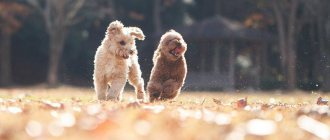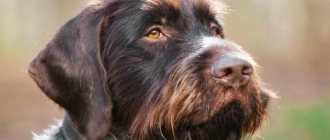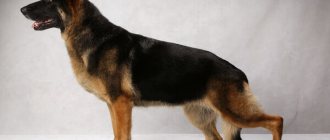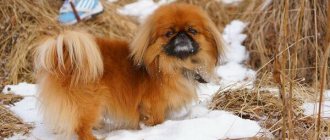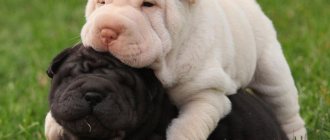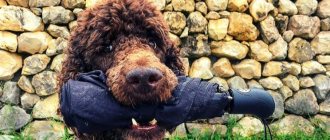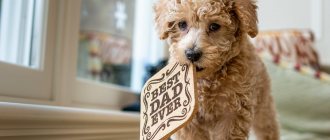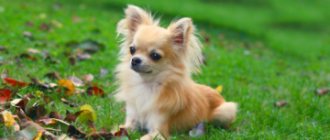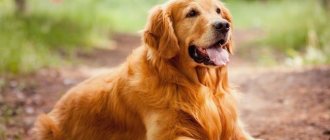Guten tag, deutsche hunds! Or hello, cute German dogs! We love dogs from all over the world - be it Chinese dogs, Japanese dogs, Australian dogs, Italian dogs or Russian dogs. So German dog breeds are in good company. They're so cute and adorable, you'll want to order some lederhosen for your next Oktoberfest!
The list we have compiled includes dog breeds that originated in Germany or regions that are now part of modern Germany. Learn more about the German dog breeds that will steal your heart—and maybe your pretzels and sausages.
German Shepherd
- Height to shoulders: from 56 to 66 cm
- Weight: from 23 to 41 kg
- Life expectancy: 7 to 10 years
- Average cost: from 450 to 1500 dollars
Regardless of what role the German Shepherd has tried on - family dog, military dog or guide dog for the blind - it is undoubtedly one of the most loyal dog breeds in the world. German Shepherds are calm, even-tempered, and loving and protective of their family (including children and their feline counterparts) with unparalleled intensity. But this does not mean that they are always in “working mode”. German Shepherds love to play and cuddle with their people, although they are constantly aware of their surroundings.
There are five main types of German Shepherds:
- American Exhibition Line;
- Western Exhibition Line;
- Western Work Line;
- DDR East Work Line;
- Czech work line.
Show line dogs compete in conformation shows such as Westminster. Working line German Shepherds are bred and trained to work as military, police, or working dogs.
Bavarian mountain hound
This breed was used by hunters to pursue prey along its blood trail back in the Middle Ages.
Representatives of this breed very quickly get used to their owner and his family, love to be the center of attention and suffer greatly if they are left alone. With the right dosage, they can exist peacefully with other pets, but some individuals find it very difficult to overcome the centuries-old hunting instinct of chasing prey.
The only disadvantage of the Bavarian mountain hound is its lack of aggression, which is why it is suitable for protection.
Representatives of this breed weigh 21-26 kg, males reach 48-53 cm in height, females - 45-49 cm. The short coat is thick and shiny, fits closely to the body, and feels harsh to the touch. The predominant color is red with all its shades.
Dachshund
- Height to shoulders: from 12.7 to 15.3 cm (miniature), from 20.3 to 23 cm (standard)
- Weight: up to 5 kg (miniature), from 7.3 to 14.5 kg (standard)
- Life expectancy: 12 to 16 years
- Average cost: from 300 to 1000 dollars
More than 300 years ago, the dachshund was bred to hunt badgers. The German word for dachshund is “dachshund” (“dach” means “badger” and “hund” means “dog”). These dogs used their narrow, long noses to explore dens, and their sharp claws and powerful short legs helped them quickly dig through the ground.
Dachshunds come in two sizes: miniature and standard. Both are ideal for those looking for an apartment dog for small spaces.
Dachshunds are persistent and very intelligent pets; They never give up , whether they're waiting for a squirrel under the deck or stretching as far as they can to get a toy bunny from under the sofa. Be prepared for them to bark until they catch their discovered “prey.”
Doberman
- Height to shoulders: from 61 to 71 cm
- Weight: from 27 to 45.5 kg
- Life expectancy: 10 to 12 years
- Average cost: from 1000 to 2500 dollars
We have a German named Louis Dobermann to thank for creating this beautiful and noble dog. As a tax collector in 19th-century Germany , Dobermann did not count on people's hospitality while collecting taxes, so he created a dog that could protect him from aggressive taxpayers and their dogs. At some point in time, the extra “n” in the name of the breed was dropped.
Despite being considered a guard dog, the Doberman is actually affectionate and sweet with his family (though he usually only forms strong bonds with one family member).
History of the origin of the species
The starting point in the pedigree of the Great Dane is considered to be 1878, when Berlin dog breeders made a “fateful” decision to integrate numerous varieties of the breed into one. Led by the active “breeder” of that period, the German doctor of medicine Heinrich Bodinus, a committee was formed that adopted a resolution on the introduction of a single classification with the general name “Great Dane”.
Occupying the position of director of the Berlin Zoo, Bodinus and a team of like-minded people achieved amazing results in breeding many animals, including Great Danes. Guard dogs, greyhounds and mastiffs were used for selection. As a result, it was possible to significantly reduce the degree of aggressiveness of dogs, which until that moment were mainly used for hunting large animals.
In 1880, competitions were held in Berlin, organized by the National Great Dane Club (Deutscher Doggen-Club, NKND). The best representatives of the species participated in the finals of the competition. The exterior characteristics of the winners were recorded, and thus the NKND in 1888 approved the standards by which the Great Dane breed should be evaluated.
To date, three varieties of Great Danes have been formed, due to the following colors:
- Straw, brindle (black stripes against a background of red shades);
- Black, marble (white or gray background with black spots);
- Blue.
Crossbreeding of individuals of different colors is prohibited and leads to the disqualification of the dog.
The Great Dane was recognized by the FCI in 2012 and is included in group 2/section 2. Molosser (2.1. Mastiff). Performance has not been tested.
Rottweiler
- Height to shoulders: from 56 to 68.6 cm
- Weight: from 36 to 61 kg
- Life expectancy: 9 to 10 years
- Average cost: from 1200 to 2000 dollars
With its impressive size and powerful body, this guard dog breed hardly looks like a cute and fluffy pet that likes to spend quiet evenings at home curled up on the sofa. However, Rottweilers are very affectionate and friendly with their human family. Strangers are more likely to encounter their arrogant and wary behavior. And it's not that they are evil dogs. Rottweilers are simply devoted to their family , and composure and restraint are a way to protect them. They are also one of the smartest dog breeds.
Pros and cons of the breed
This breed is suitable only for energetic people who prefer an active lifestyle and know about the rules of care and the nuances of raising German hunters.
AdvantagesDisadvantages
| Tireless fighter and fearless hunter | Aggression towards other animals |
| Miniature sizes allow you to feel confident in burrows | Explosive character |
| There is no innate predisposition to common diseases in dogs | Difficulty of training |
| High endurance and indifference to weather conditions | Will chew on everything it can reach if the necessary physical activity is not provided |
| Furious pursuit of the beast to the end | |
| Unique devotion to the owner | |
| Can make independent decisions | |
| Excellent makings of a born guard |
This freedom-loving dog breed is truly happy only during the hunt, where it can use the skills that nature has endowed it with.
In a family where there are no avid hunters, the Jagd Terrier may behave inappropriately. Even constant walks for several hours will not be able to release all the energy that exists within this tireless pursuer of prey.
If the dog’s owner is ready to devote all his free time to his beloved pet, to take him to a site specially equipped for burrowing breeds, where all conditions are as close as possible to real hunting, then the Jagdterrier will feel good in a city apartment.
Boxer
- Height to shoulders: from 54.6 to 63.5 cm
- Weight: from 29.5 to 36.3 kg
- Life expectancy: 10 to 12 years
- Average cost: from 500 to 2500 dollars
The Boxer is an intelligent and energetic dog that loves to be active and keep busy, preferably with its family. Life in an apartment will be much more tolerable and bearable for him if he is not left alone for a long time .
Don't let your Boxer spend too much time on his own, otherwise he will find ways to amuse himself, such as knocking over a trash can, destroying couch cushions, etc.
The boxer's popularity peaked in the 1950s when a winning boxer at Westminster named Bang Away became a celebrity. Then in 2022 and 2022, a boxer named Cinnibon's Bedrock Bombshell wowed the judges and spectators by taking first place in the working dog class.
Weimaraner
- Height to shoulders: from 58.4 to 68.6 cm
- Weight: from 25 to 40.8 kg
- Life expectancy: 10 to 13 years
- Average cost: from 700 to 1500 dollars
The Weimaraner, known as the "gray ghost" mainly due to its coloring, stealth hunting skills and speed, is not a couch potato. Well, at least until all of his physical exercises are completed for the day.
These are very active dogs, great for running and walking . They are so focused on human interaction that “me time” is a foreign concept to them. Several famous people, including Grace Kelly and President Dwight D. Eisenhower, helped popularize the Weimar Cop.
Pomeranian Spitz
- Height to shoulders: from 15.2 to 17.8 cm
- Weight: from 1.5 to 3.2 kg
- Life expectancy: 12 to 16 years
- Average cost: from 800 to 5000 dollars
What's cuter than a fluffy, pint-sized dog that also looks like a miniature fox? This tiny breed of toy dog is very energetic and friendly .
Pomeranians' curiosity stimulates their natural desire to learn new tricks and also makes them alert watchdogs.
The Pomeranian has kept company with some prominent historical figures, including Wolfgang Amadeus Mozart, Queen Victoria and Marie Antoinette.
How to choose a puppy
Puppies of this breed are adopted after reaching the age of 1 month. During this period, babies begin to eat on their own.
When choosing a pet, pay attention to the following facts:
- Availability of a hereditary certificate.
- The baby should be calm, but at the same time energetic and demonstrate slight aggression. The dog is observed during play: when other dogs pester it in a calm state, it should initially not react in any way, and then it should fight back and instantly calm down.
- A healthy pet will never allow itself to be overcome during play.
- When feeding, the baby should quickly push away the weaker ones, making his way to the mother's nipples first.
- A German must have a confident bowel movement and a good appetite.
A mentally balanced Kurzhaar should not express fear at the sight of strangers, but on the contrary, try to get to know them better.
Similar breeds
| Drathaar | German Jagdterrier | Springer Spaniel |
German dog
- Height to shoulders: from 71 to 81.3 cm
- Weight: from 49.9 to 79.4 kg
- Life expectancy: 7 to 10 years
- Average cost: from 600 to 3000 dollars
Unarguably the tallest dog breed in the world, the Great Dane towers menacingly over its four-legged friends and most people when it stands on its hind legs. While other giant dog breeds may appear large and clumsy, the Great Dane's elegant and regal gait rivals those of top models on the runway.
These gentle giants have hearts as big as their paws. Great Danes are patient and affectionate with all members of their family and reserved with strangers.
Schnauzer
- Height to shoulders: 30.5 to 35.6 cm (miniature), 44.5 to 49.5 cm (standard), 59.7 to 70 (giant)
- Weight: 5 to 9 kg (miniature), 13.6 to 22.7 kg (standard), 25 to 38.6 kg (giant)
- Life expectancy: 12 to 15 years (miniature), 13 to 16 years (standard), 12 to 15 years (giant)
- Average cost: from 500 to 2700 dollars
Schnauzers come in three sizes, and all are energetic, enthusiastic , and adventurous. To thrive, Schnauzers need to expend their energy during daily walks and use their sharp minds during playtime.
Although they are eager to please their owners, they are still a bit independent and may do things their own way from time to time.
Try a dog puzzle toy to keep your schnauzer mentally occupied (and not mischievous). As family dogs, they are sweet with their family and great with children and other dogs.
Giant Schnauzer
A large and strong Giant Schnauzer with coarse hair and a typical mustache is a strong and efficient dog, which, thanks to its incorruptible devotion to its owner, can be not only an excellent service dog, but also a family dog. Energetic daredevils have enormous stamina and resilience, making them sometimes difficult to stop in their quest for action.
Giant Schnauzers have not only an energetic character, but also a remarkable inner calm, which makes them extremely good-natured and adaptable companions. They remain even-tempered into old age, so they are always alert and playful, never nervous or aggressive.
His innate protective instinct should not be underestimated, because the vigilant schnauzer is quite capable of courageously and fearlessly intervening when he sees his loved ones in danger. With a height of 60 to 70 cm at the withers and a weight of 35 to 50 kg, he is undoubtedly an imposing figure that commands respect. But his dachshund look from under thick, extravagant eyebrows shows that behind the strong shell there is a kind heart.
German Spitz
- Height to shoulders: from 30.5 to 38 cm
- Weight: 10.9 to 11.8 kg
- Life expectancy: 13 to 15 years
- Average cost: from 400 to 700 dollars
The German Spitz is a little fireball: he reacts to commands with lightning speed and can quickly learn new tricks . This is a truly happy-go-lucky breed that is devoted to the whole family, including other family dogs. They make excellent little watchdogs, but their built-in (barking) alarms can be overly loud and annoying.
Have you noticed how much the German Spitz looks like the Pomeranian? These dog breeds are always confused by everyone because of their thick double coat, fox-like faces and fluffy tails that curl up.
Leonberger
- Height to shoulders: from 64.8 to 80 cm
- Weight: from 40.8 to 77 kg
- Life expectancy: 7 years
- Average cost: from 1500 to 2000 dollars
If you're looking for a huge, fluffy dog to play with and cuddle with, look no further than the Leonberger. Of course, at first glance it could pass for a breed of dog similar to a bear or even a lion, but unlike these two wild animals, the Leonberger is not at all ferocious. These pets are extremely patient and affectionate with their family, and they easily make friends with people outside the family circle.
Care and maintenance
Considering the fact that this breed is small, the Jagdterrier can be kept in an apartment or in the courtyard of a country house, but the fence needs to be strengthened, because the dog likes to dig the ground and can make a dig to break free.
The right diet
The main thing in caring for a puppy is proper feeding at strictly designated hours.
You can feed an adult dog or puppy high-quality dry food or balanced natural food, where meat, cereals and vegetables occupy the main place. Puppies aged 2.5–4 months should be fed 4 times a day, then reduce feeding to 3 times.
Note. At the age of 8 months, the puppy is transferred to feeding 2 times a day.
It is recommended to feed an adult Jagdterrier no more than 2 times a day; a female is fed up to three times, especially when she is carrying puppies. After consultation with a veterinarian, you can give a complex of vitamins seasonally.
List of prohibited products:
- River fish;
- White bread;
- any sausages;
- smoked meats;
- fried and fatty;
- pasta and legumes;
- homemade cakes and sweets.
Walking and physical activity
While walking with a future hunter, the owner must understand that the dog will chase any moving targets, including cars and motorcyclists, so under no circumstances should the animal be let off the leash.
The Jagdterrier is endowed with enormous energy, which does not dry out after several hours of active exercise. It is recommended to train the dog in specially fenced areas so that the reckless hunter does not accidentally run away.
The best option for a walk is going out into nature.
Remember. The Jagdterrier is a fairly active breed and can run and play for hours without feeling tired at all.
Training and education
You need to start training a Jagdterrier from six months and no later than 10 months from birth. The puppy learns simple commands quite quickly, but the nuances of hunting are taught in centers for training burrowing dogs, where there are special simulators.
Training is carried out twice a day for one hour before feeding or 2-3 hours after.
Training takes at least six months, but the dog must not be overloaded; this process must be combined with raising the pet.
The owner of a Jagdterrier must understand that representatives of the breed are stubborn and have high intelligence, so it is important to find points of interaction and not suppress the dog’s character.
On a note. In no case should you be punished corporally for offenses; it is enough to reprimand them strictly, because Jagdterriers perfectly distinguish intonation and will understand that the owner is extremely dissatisfied with them.
Some dog handlers advise using a rolled-up newspaper - light blows to the nose or ears will have a stronger impact than a strap or a torn branch.
Raising a Jagdterrier is an art based on respect for your pet. It should be remembered that without proper training, this breed turns into a threat to all living things. Therefore, it is important to start training your puppy from an early age.
Care and hygiene
Coat care is important: it needs to be brushed several times a week, especially when the dog is kept in an apartment, because this breed sheds heavily when exposed to excess heat. There is no need to bathe the Jagdterrier often, unless he got dirty during a country walk in the mud or managed to swim in a river or lake.
After bathing your pet, you need to dry it thoroughly and not take it outside so that the fur is completely dry. This procedure is usually performed before a night's rest.
Particular attention should be paid to the eyes, as dirt can accumulate in the corners. It is removed with cotton swabs, having previously moistened them in a special solution. In case of pathology, you should immediately take your pet to the veterinarian.
After each walk, you should carefully examine your ears so that ticks or other parasites do not settle there.
To clean your dog’s teeth from unwanted plaque, you can buy special sticks at the pet store: your pet will happily chew on them and at the same time clean his sharp teeth.
It is recommended to trim the nails regularly. If the dog is walked only within the city limits, then the claws can grind down on the asphalt. But, nevertheless, it is important to periodically check their length.
Kurzhaar
- Height to shoulders: from 53.4 to 63.5 cm
- Weight: from 20.4 to 31.8 kg
- Life expectancy: 10 to 12 years
- Average cost: from 800 to 1500 dollars
If you prefer to hike, run, swim and explore nature instead of lying on the couch, the Shorthaired Pointer (German Shorthaired Pointer) will be your best adventure companion. As a hunting breed , the shorthaired pointer is naturally inclined to be inquisitive and an enthusiastic explorer.
The German Pointer forms strong bonds with his family and loves to frolic with children in the backyard, and he will not refuse a vacation at the lake with his family.
Character and behavior
The full character of this breed can only be revealed during a hunt; in everyday conditions, Jagd Terriers are unbalanced and stubborn.
Normal conditions of coexistence for this dog:
- constant movement;
- search and pursuit of prey;
- attached only to the owner, can dominate over other family members.
Important. With constant physical activity and proper training, Jagd Terriers are ideally obedient and restrained when communicating with strangers or representatives of the fauna.
The dog can play with children, but does not tolerate excessive affection, has high intelligence and is easy to train at an early age.
The dog's temperament is hyperactive, so it cannot be locked up for a long time - it needs constant movement and space, so it is difficult to keep a Jagd Terrier in an apartment, since the pet needs to be walked twice a day for at least 2 hours.
When walking in the city, a leash is required, otherwise the pet may be carried away by the excitement of the hunt, then it will no longer listen to any shouts or orders, but will pursue the prey to the end.
This breed can coexist with other pets (except rodents); Jagdterriers need to be accustomed to neighbors gradually.
Poodle
- Height to shoulders: up to 25.4 cm (dwarf), from 25.5 to 38.1 cm (miniature), over 38.1 cm (standard)
- Weight: from 1.8 to 2.7 kg (dwarf), from 4.5 to 6.8 kg (miniature), from 18 to 31.7 kg (standard)
- Life expectancy: 10 to 18 years all sizes
- Average cost: from 600 to 2000 dollars
You've heard the term "French poodle" and have probably seen pictures of the typical white poodle with aristocratic manners strolling the streets of Paris. Well, wouldn't you know it, the Poodle is actually one of 47 dog breeds with German roots. They started their journey as duck hunters .
Poodles are excellent athletes, especially when it comes to swimming. They are also top-notch family dogs. They are friendly to almost everyone, and are even one of the few dog breeds that get along with cats . In addition, poodles are easy to train.
Based on materials from: www.rd.com
Miniature Schnauzer
<
The history of the Miniature Schnauzer dates back to 15th century Germany. This breed was created by crossing small standard schnauzers with poodles and Affenpinschers.
The breed was used to keep vermin out, especially around barns. Miniature Schnauzers tend to be friendly, intelligent, and eager to please. But they are known to be alert barkers.
